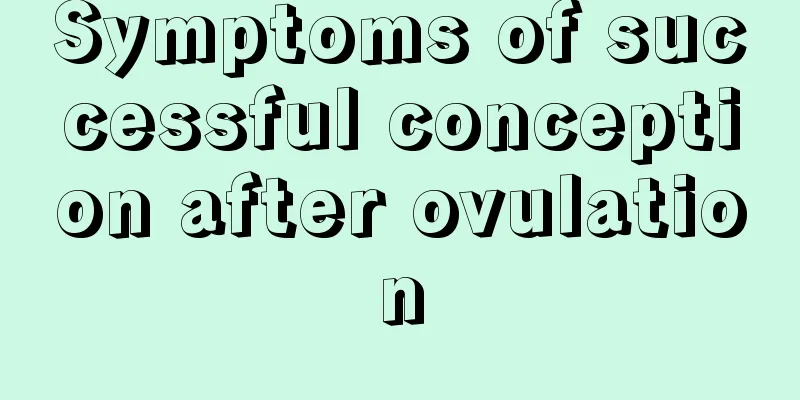Symptoms of successful conception after ovulation

|
Many couples who are preparing for pregnancy know that it is easier to get pregnant during a woman's ovulation period. Women experience ovulation once a month. Under normal circumstances, women will ovulate a mature egg every month. When a woman successfully conceives during the ovulation period, some symptoms will appear in her body. If a woman observes carefully, she will find these changes, such as feeling uncomfortable in the stomach, going to the toilet frequently, and being particularly tired. Symptoms of successful conception after ovulation 1. Feeling nauseous. Some people begin to experience symptoms of morning sickness in the first few weeks after conception. You may feel nauseous or queasy. Although morning sickness is also called "morning sickness," queasy symptoms are not limited to the morning. You may feel nauseous and want to vomit all day and all night. 2. Breasts become softer. If your breasts feel tingly, tender, and swollen, you may be pregnant. This symptom may appear within the first few days after conception. After your body adjusts to the influx of hormones, this pain will subside and your breasts will no longer feel uncomfortable. 3. Feeling tired. The surge in progesterone (a hormone) can make you feel exhausted. Almost all pregnant women suffer from this symptom, and you can observe other symptoms to confirm your suspicion. 4. Going to the toilet frequently. After the fertilized egg implants in the uterine wall, it begins to secrete human chorionic gonadotropin (hCG). This will stimulate you to urinate more frequently, so you will go to the bathroom more often than before. 5. Bleeding or cramps. In the eight days following ovulation and implantation, you may experience light pink or brown staining, and cramping may accompany this. There may be some spotting during the menstrual period, but this is not a true menstrual period. This is the result of a fertilized egg implanting in the uterine lining. Is it possible to get pregnant during ovulation? The ovulation period, which lasts for 10 days, is the period when women ovulate. A woman's ovulation day is generally about 14 days before her period, and then the ovulation day together with the five days before and the four days after it. The fertilized egg is the combination of sperm and egg, so the amount of egg released increases during ovulation. Therefore, as long as couples planning to have a baby understand the ovulation period well, calculate the ovulation period accurately, and make good use of the ovulation period, it is often a piece of cake for them to conceive successfully. In other words, the chances of getting pregnant are high if you have sex during ovulation. A woman with normal body functions can release a mature egg in a month. If it can successfully meet the sperm during ovulation, there is a great chance that it will become a fertilized egg, thus making it possible to successfully conceive a baby. Therefore, being able to accurately calculate the ovulation period is crucial for friends who are preparing for pregnancy. The ovulation period can be calculated according to the menstrual cycle. It is generally counted from the first day of the next menstrual period. Counting down 14 days or subtracting 14 days is the ovulation day. The 5 days before ovulation, the ovulation day, and the 4 days after ovulation, the sum of these three times is the ovulation period. For female friends whose menstruation is irregular, the method of calculating the ovulation period is a little complicated. At this time, the ovulation period is calculated as follows: the first day of ovulation = the shortest menstrual cycle minus 18 days; the last day of ovulation = the longest menstrual cycle minus 11 days. For example, the shortest menstrual period is 28 days and the longest is 37 days. The shortest regular period is subtracted by 18 (28-18=10) and the longest regular period is subtracted by 11 (37-11=26). Therefore, the ovulation period is from the 10th day to the 26th day after the menstrual period. Friends who find the menstrual calculation method troublesome can also go to the pharmacy to buy ovulation test strips. After using them according to the instructions, if two lines appear (i.e. positive), it may be the ovulation period, but it does not necessarily mean ovulation. There are also weak positive and strong positive. Only when a strong positive appears (i.e. the two lines are almost the same color or the test line is darker than the control line), it indicates that ovulation will occur within 24-48 hours. Although the accuracy rate of this method is about 75%, it is very convenient. Many female friends who are preparing to become pregnant will also use this method to measure their ovulation period. |
<<: Applying hot compress to the abdomen after ovulation can help pregnancy
>>: Why is it easy to catch a cold after ovulation
Recommend
The body is hot but not feverish
If your body is hot but you don't have a feve...
What to do if the femoral head is broken
People's bodies seem strong but are actually ...
Can nasopharyngeal cancer be transmitted to children?
Can nasopharyngeal cancer be transmitted to child...
Ask about tongue cancer diagnostic tools
Relevant oral experts said that tongue cancer is ...
Will having too many abortions lead to uterine cancer?
Clinically, many women suffer from cervical cance...
What are the symptoms and signs of kidney cancer
What are the symptoms and signs of kidney cancer?...
What causes heart pain?
The feeling of heart distension and pain is exper...
What types of dentures are there
Once there is a problem with teeth, it will bring...
How to make sweet potato candy
When winter comes, there will be a lot of sweet p...
The correct way to remove freckles with olive oil
When faced with pigmentation, everyone will go to...
Is fried yogurt hot or cold
Many people think that fried yogurt is hot, but i...
How to solve the problem of bloating caused by drinking beer?
In summer, everyone likes to drink beer, eat barb...
How to use hyaluronic acid gel
Girls all know about skin care products such as h...
What should I do if I faint at the sight of blood?
Blood is the most important substance in the huma...
How to sleep after sex to facilitate implantation?
Before the couple prepares to have a baby, they n...









